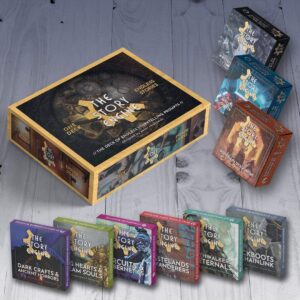Writing Tools: Story Engine
 I’ve accumulated a large collection of card-based writing tools, each of which is useful to different parts of my writing process. So I’ve decided to do a series of posts about the various decks I own and how I use them in my writing.
I’ve accumulated a large collection of card-based writing tools, each of which is useful to different parts of my writing process. So I’ve decided to do a series of posts about the various decks I own and how I use them in my writing.
Story Engine is an amazing deck-based plot generator. It lets you put together as few or as many cards as you want to come up with a plot. The instructions include methods to use if you already have some elements of your plot in mind or if you’re coming up with a brand new idea. I’ve used it to come up with ideas for things as small as 100-word drabbles all the way to 3,000-word short stories (and I suspect you could get longer stories out of it as well)!
Story Engine has five types of cards: Agent, Engine, Anchor, Conflict, and Aspect. The first four card are the ones that build the plot, by giving you a character, what they want (a combination of the Engine and Anchor cards), and what’s in their way. The Aspect cards let you add additional detail to the other four cards. You can also choose to add additional characters, wants, or things in their way, and as many additional details as you like.
The Agent, Anchor, and Aspect cards each present four options, while the Engine and Conflict cards only present two options each. The initial deck is generic enough to be used for any genre, but the expansion packs add genre-specific ideas to each type of card. You can use those packs separately from the main deck, mix in some expansions with the main deck if you want to stick to a specific genre, or throw all of the expansions into the mix to get some occasionally bizarre but still workable story ideas.
The instructions also suggest that if you know part of what you want to write, you can “lock” that card slot rather than choosing something random. For example, if I want to write a story about a superhero character I’ve already developed, I could “lock” the Agent slot, and only draw from the other decks. If I want a specific MacGuffin or location, I could “lock” that into the Anchor slot.
One thing that I’ve found when I use the Story Engine deck is that I’m more likely to draw a single Agent, Anchor, and Aspect, and choose from among the four options presented there, but I sometimes need to draw a few Engine and Conflict cards before I find one that really works for me. I’m not sure if this is related to those cards only having two choices each instead of four, or if some of them are a little more specific than I’m looking for at times.
The Story Engine cards are square and of a very manageable size for shuffling. When you start adding a bunch of expansions to the main deck, each deck type might get a little unwieldy, but I’ve had good luck splitting my deck types in half and shuffling each half separately, and then giving it one or two quick shuffles together. The Agent, Anchor, and Aspect cards have a little bit of art in the background, but the most useful part on all the cards is the clear printing and the symbols for the various expansion packs.
In addition to the Story Engine cards and expansions (of which there are even more than what I have!), there’s also a Deck of Worlds worldbuilding system that won’t be out for another year, but can be preordered now.
In summary, use Story Engine for: plot generation for stories, RPGs, or whatever you need a plot for!

Comments